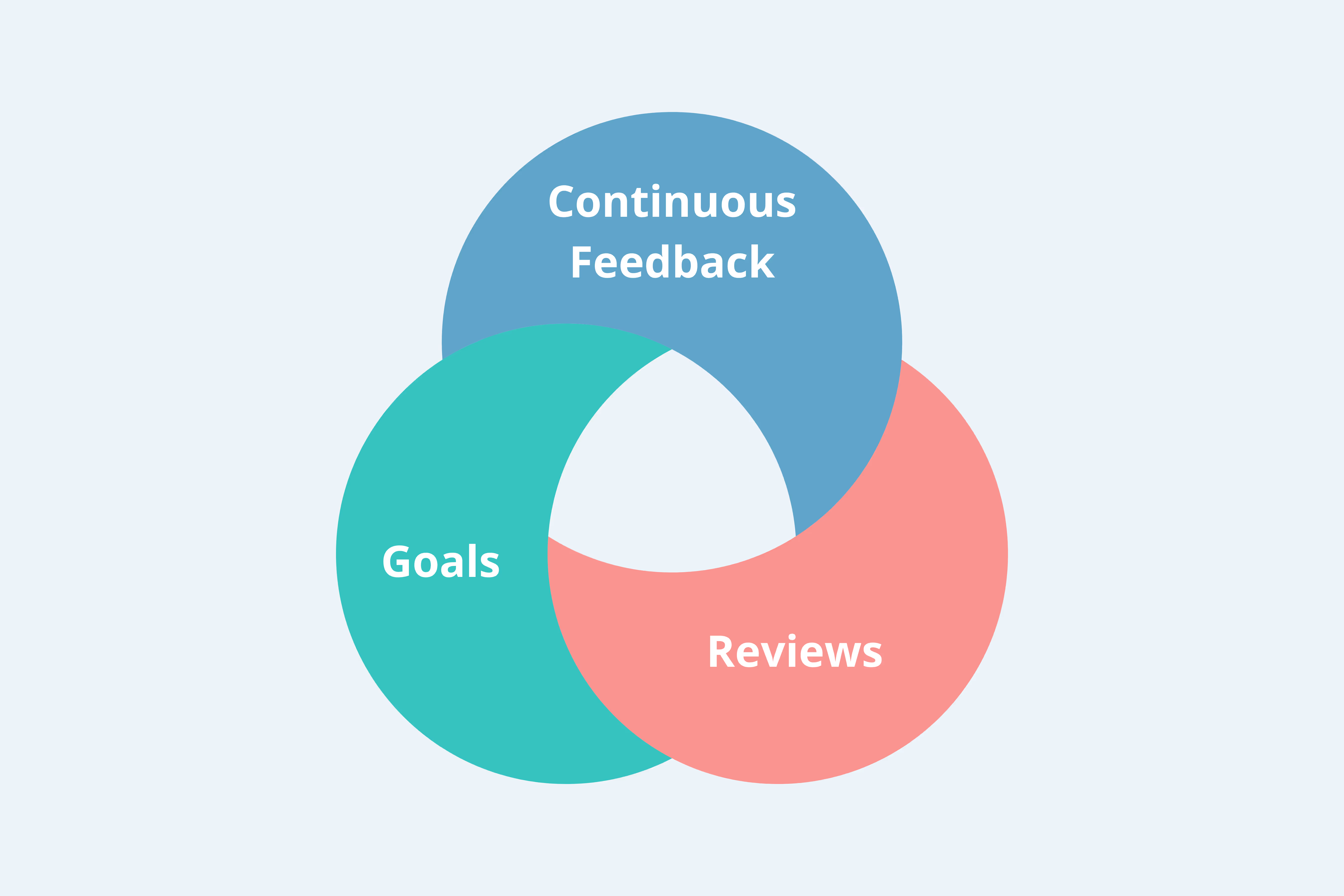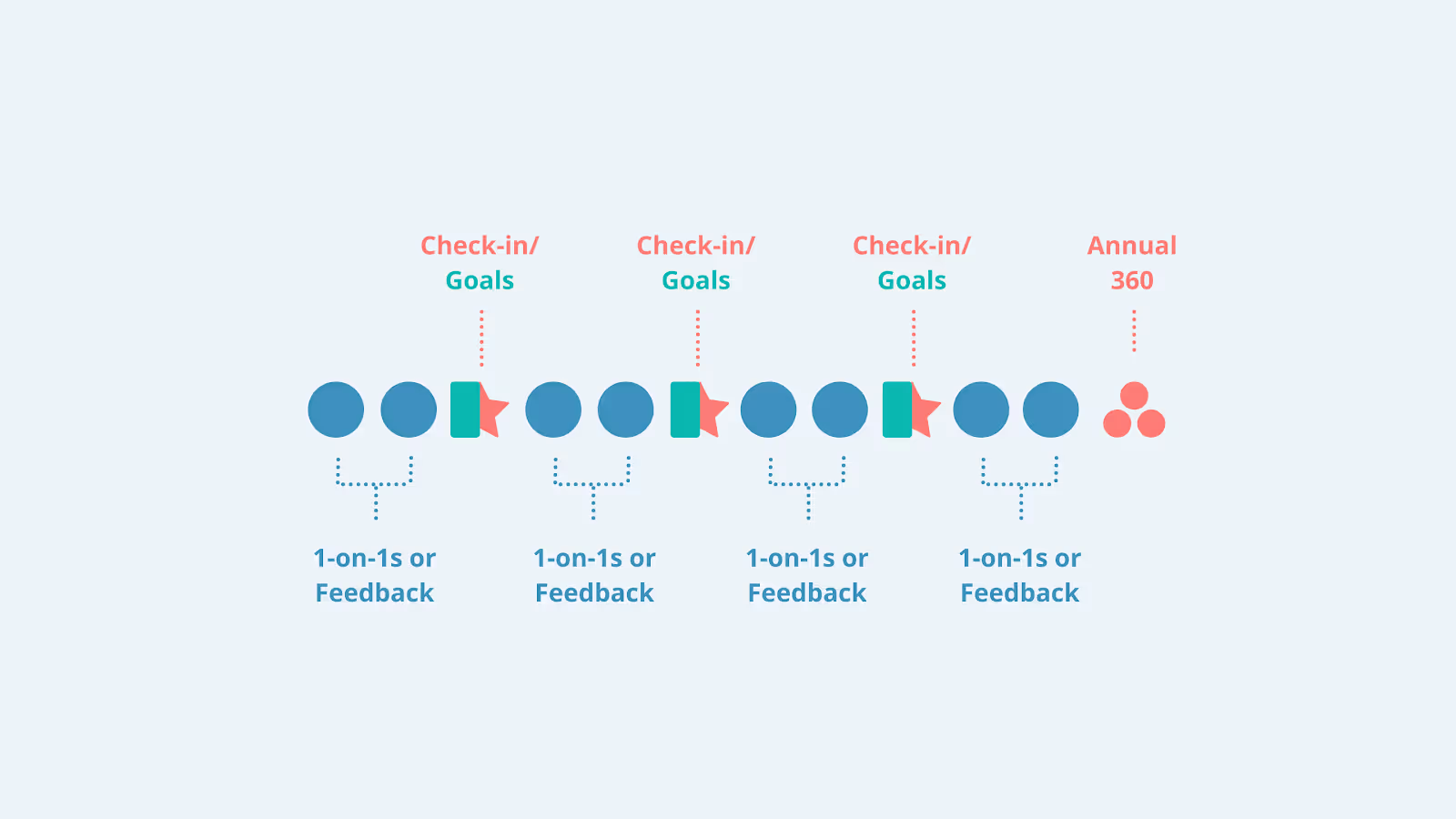3 Elements of Performance Management (And Why You Should Focus On Them)
From Adobe’s “Check-In” to Google’s “OKRs”, there are dozens of performance management tactics out there.
No matter what performance management approach you choose for your organization, we believe an effective performance management process is centered on three elements: holding structured reviews, setting goals, and providing continuous feedback.
Let’s take a closer look at each of these elements to better understand how they work together to create a complete performance management strategy.
Structured Reviews
Annual reviews have gotten a bad rap in recent years, but some form of long-term structured feedback should still be the backbone of any performance management strategy. You can call them quarterly conversations, year-end check-ins, development discussions or something else, but the important thing is that you provide a place for discussions about long-term performance.
Some of the most meaningful feedback employees can receive will be about long-term trends, high-level development opportunities, overall performance, or their career progression. Merit increases, which are salary adjustments based on performance, can also be discussed during these reviews, providing a tangible incentive for employees to strive for continuous improvement. These types of discussions often struggle to find their place amongst everyday responsibilities. By creating a structured review process, organizations make space for these important conversations.
Adam Hoffman, Director of Talent Management at Porte Brown, described the cultural shift in their performance management process since they started using performance management software:
“I feel that people have a lot less anxiety going into a review meeting and are generally happier coming out. We’ve come a long way with our performance management process.”
Most of the issues with annual reviews come from poor processes, rather than an issue with long-term feedback. Consider simplifying your forms, asking more open-ended questions, increasing the frequency, and soliciting more sources of feedback (e.g. 360 reviews). These changes can help you maintain the benefits of long-term feedback while fixing many of the issues with annual reviews.
Goals
Goals in performance management are the bridge between talking about performance and taking action on feedback. Whatever form it takes, performance management should never solely focus on the past. The reason for performance discussions is to drive positive change in the future. Goals are the best way to ensure this important next step is taken.
Employees who set 20–30 goals per year complete 38% more goals than those who set 5 or fewer goals, according to the PerformYard State of Performance Management Report.
When goals are set coming out of a performance discussion, the conversation is forced towards actionable next steps. This creates a more constructive dynamic and ensures that managers and employees collaborate not just on where to improve, but how to improve. Additionally, well-set goals will include a due date, which means that feedback will be followed up on.
Structured reviews and goal setting come together to create a system where performance is discussed, next steps are agreed on, and progress is reviewed. This begins to form the primary cycle of an effective performance management process.
Continuous Feedback
Continuous feedback ties the long-term feedback from structured reviews and the intentions set through goals to a person’s everyday work.
Without a process for more continuous feedback, the review and goal-setting cycle can start to feel disconnected from a person’s day-to-day experience. Feedback takes the role of tying everything together.
Imagine that during a quarterly check-in, your manager shares they believe you could benefit from a “systems approach” to your work. Maybe that’s good feedback, but you two are probably a long way from being on the same page about what that means. Your manager may even try to provide examples, but it’s hard to remember the details of what happened months ago.
Continuous feedback creates the opportunity for your manager to bring up this idea in the exact moment that it’s relevant. As a result, you are able to discuss their feedback with the context of the project you just finished working on.
If the systems approach idea comes up multiple times throughout the quarter, you’ll be better prepared to discuss what to do about it during your quarterly check-in.
Managers who provide some form of continuous feedback, either in real-time, through 1:1s, or another way create a base of ideas that they can pull from at review time.
📈 Performance Management ROI Calculator
Reviews, Goals, and Feedback: A Continuous Cycle

When done right, reviews, goals, and continuous feedback can reinforce each other in a complete cycle of performance management.
Continuous feedback is a constant source of new ideas for performance improvement, reviews are an opportunity to reflect on and discuss that feedback over the long term, goals help turn the conversation into action, and then feedback comes back in to reinforce goal progress and continues to raise new ideas for the next review and goal-setting cycle.
This cycle helps employees reflect on their performance, take action, monitor their improvement, and then reflect again. Almost every performance management approach can be broken down to this type of cycle and these three elements.
Examples
The examples below illustrate two ways organizations can bring the elements of performance management together in a complete process.

Acme Corporation is a software company that has about 150 employees. Acme’s performance management system focuses on cultural alignment and employees are evaluated on how well they live up to cultural values.
Acme conducts an annual review at the end of every year where managers review long-term performance, goals, and feedback with their employees. After the structured reviews take place, goals are set for the upcoming year. Weekly 1:1s are held throughout the year to facilitate continuous feedback. Feedback is recorded and saved to reference for the next structured review and goal-setting cycle.

Wayne Enterprises is an accounting firm that has 40 employees. Wayne Enterprises uses a development focused performance management strategy where employees are evaluated on growth or pursuit of development. The organization conducts an annual 360 review with five raters at the end of each year.
After annual reviews are completed, employees set goals for the new year. Employees have a 1:1 meeting with their manager every other week to discuss what they’re working on, how their work supports their goals, and what progress is being made towards their goals. A check-in is held at the end of each quarter to review previous goals and set goals for the new quarter. Managers use notes from quarterly check-ins and 1:1 meetings to conduct the annual review.
While the process looks different for Acme and Wayne Enterprises, both processes bring structured reviews, goals, and continuous feedback together into a continuous cycle that supports organizational goals and efforts.
No matter how you choose to bring them together, each element should work together to complete your performance management process.
If you’re looking to manage the elements of performance management in one place and streamline your process, check out PerformYard—a powerful performance management software. PerformYard makes it easy to set goals, conduct reviews, and gather real-time feedback.
Request a demo or visit our website to see how PerformYard's deep feature set can accommodate your unique performance management strategy.

.jpg)

.jpg)
